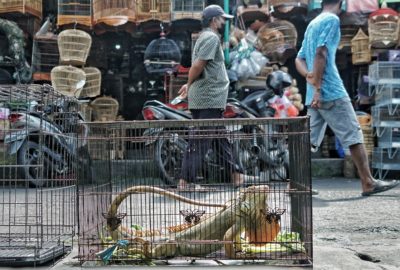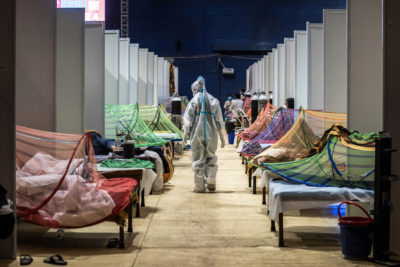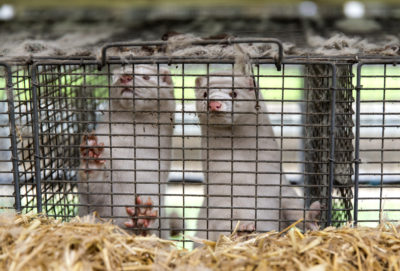Author David Quammen was well placed to see the pandemic coming: almost 10 years earlier, he had written a book called Spillover: Animal Infections and the Next Human Pandemic. Covid-19, when it came, did not surprise him: researchers had been anticipating a pandemic from an RNA virus for more than a decade. But the lack of preparedness did.
Since the Covid-19 pandemic struck, Quammen — stuck, like so many of us, in his house — hit Zoom and interviewed more than 95 scientists and health experts around the world. His mission was to track the origins of the SARS-CoV-2 virus, which causes Covid-19, untangling the scientific hunt for its start and its spread and the development of vaccines to fight it. The result is his new book Breathless: The Scientific Race to Defeat a Deadly Virus.
Quammen has spent 40 years writing about conservation and sees links between the loss of habitat and biodiversity and the pandemic. In an interview with Yale Environment 360, he talks about what is now known about the origins of the SARS-CoV-2 virus, the likelihood of another global pandemic, and the path forward.
Yale Environment 360: In your book, you trace the scientific hunt for the origins of SARS-CoV-2. The first, quickly discredited proposal was that it came from snakes. Then the focus moved to bats, then pangolins, then a possible lab leak. Is there a final consensus?
David Quammen: There is a consensus among experts that it came almost certainly from a wild animal, most likely a horseshoe bat from somewhere in southern or Central China, and spilled over into humans, possibly by way of an intermediate animal.
There are still people arguing what I call the “nefarious origins”school of thought, which encompasses the idea that it’s an intentionally engineered virus, or that it was a virus manipulated for scientific reasons in lab, or that it was a wild virus brought into the lab and cultured and that accidentally escaped. Do we know, absolutely, that this was not the result of a lab leak? I’d say we know with 98 or 99 percent probability … You can’t persuasively argue or infer that this virus resulted from a lab leak until you place this virus in a lab somewhere. And there is no evidence whatsoever that this virus existed in any viral lab that works on coronaviruses.
We may never find the precursor virus of this virus, the one that’s 99.6 percent similar to the original Wuhan strain. We hope that we will. But that virus presumably exists in a horseshoe bat somewhere in southern China, and that virus could potentially go extinct before we find it … It took 41 years to identify the reservoir host of Marburg virus. And for the original SARS virus of 2003, it took 14 years. So when people say, “Oh, if this had come from a wild animal, we would have found it by now,” they really just don’t know what they’re talking about.
“It most likely was not just one animal carrying a coronavirus like this. It was a virus being shared among animals.”
e360: You cover one prominent idea that there was no one single origin of SARS-CoV-2, but rather that two closely-related strains (A and B) both emerged from animals at around the same time and place — the Huanan seafood wholesale market in Wuhan (which sold live animals). This seems a remarkable coincidence to me — is it likely?
Quammen: It does seem a remarkable coincidence. But it’s not, if you understand that viruses circulate from animal to animal all the time. If you put a whole lot of animals of different species together in a wet market — meaning live animals for sale as food stacked in wire cages on top of one another — it is just the ideal situation for the transmission of viruses from one animal to another and from animals into people. It most likely was not just one animal that was carrying a coronavirus like this. It was a virus that was being shared among animals, probably across species boundaries. And those various different animals were all coming in contact with humans. And that makes it seem very plausible that it would spill over twice.
e360: Or more than twice?
Quammen: That’s right. As one scientist has said, “Spillovers are common, but pandemics are rare.” Viruses are continually spilling over from animals into humans, and most of them do not cause big outbreaks or pandemics. Most of those infections come to a dead end.
There are large numbers of people who live around the habitat of horseshoe bats in southern China; if you test their serum, they test positive for antibodies against SARS-like coronaviruses, and they’ve never reported themselves sick or been part of an outbreak. They’ve just been living there. And they’ve been exposed to these viruses.
Live animals on sale at the Satria Bird Market in Bali, Indonesia.
Amilia Roso / The Sydney Morning Herald via Getty Images
e360: Another idea you cover is that the pandemic is the result of a “double accident.” Can you explain?
Quammen: First of all, there’s the accident of the spillover. A human comes into contact with an animal that’s carrying a virus, and the virus takes hold in the human and causes an infection. The second accident that’s required for a pandemic is opportunity for spread. So, for this virus, the city of Wuhan has 11 million people; it’s a hub for the high-speed railroads; and it has an international airport. And so, very quickly, this virus was riding trains and airplanes.
At the same time, there is a pig-infecting virus that killed off a lot of pigs in China. This was a cataclysmic event for pork production: prices rose drastically, and people were seeking alternate forms of meat, including wild meat. This might have been a factor, but we don’t have proof to confirm that. And there were festivities around the Chinese New Year in January of 2020. There was a community potluck in the city of Wuhan involving [about] 40,000 families. The authorities let that banquet go ahead right as this virus was trying to find new humans to infect.
e360: There were two ideas in your book that really struck me as frightening. The first is that there are many, many more coronaviruses out there than we know about.
Quammen: Every kind of animal, plant, fungus, bacteria, archaea has its own viruses. Viruses are everywhere. They’ve been called the single largest repository of genetic information on the planet. Not all of those are potentially capable of infecting humans. But a lot of them are. And we have only this tiny sample of those.
“We need to make prioritizing decisions. Is it viral discovery and prediction? Or is it surveillance and response.”
e360: So, should we ramp up study of those viruses?
Quammen: There are two schools of thought. One emphasizes viral discovery and prediction: we should sample viruses all over the world from all kinds of animals — bats, in particular, [and] rodents — and we should inventory all of those viruses and look at the ones that seem like they might be able to attach to human cells and make people sick. The other school of thought is that, well, you can never really predict which virus is going to spill over. What we need is a very, very strong system of surveillance and response. At the point when they are only infecting a few people, we need to detect that with surveillance and then respond with ways of containing it.
It’s very important that we do both of those things. But resources are finite. So, we need to make prioritizing decisions. Is it viral discovery and prediction? Or is it surveillance and response?
e360: Where do you stand?
Quammen: I don’t strongly, myself, argue either of those. I’m still listening. But I am persuaded that surveillance and response is a sector that’s very, very underappreciated, under-supported, under-financed, and underdeveloped. What I mean by surveillance is, for instance, routine blood sampling of people who work in big poultry operations, or on big industrial-scale pig farms, or in contact with wild animals, even if they’re not saying “I’m sick.”
e360: Does anyone do that?
Quammen: Yeah, it’s done in some places, but not nearly enough. I talked to five experts on this a couple of weeks ago for something I’m trying to write right now. And all five of those people, all of them influenza experts, all said surveillance is not adequate.
e360: Is there any one place that people point to as an example of good practice, such as a country or even just a farm somewhere?
Quammen: If so, I haven’t heard about it.
e360: The second frightening concept for me is your description of the ‘sylvatic cycle’: the idea that a virus can cycle back and forth between wildlife and people. Is there some evidence that SARS-CoV-2 has gone back into animals?
Quammen: There’s a ton of evidence. It began early on, when some person who was sick with this virus had a Pomeranian dog and the dog tested positive. A German Shepherd in Hong Kong also tested positive. And then very quickly, a cat in Belgium; a cat in France; tigers at the Bronx Zoo in New York; snow leopards at a zoo in Louisville; gorillas at a zoo in San Diego. Mink all across Europe now seem to be infected with this virus. White-tailed deer in Iowa, in Pennsylvania, in Michigan are testing positive at high rates. There may soon be evidence that it has gotten into mice in the wild. We should not be surprised if we hear that.
So there has been a passage of this virus into all kinds of animals. And that means that it can also pass from them back into us.
e360: What can we do about spillovers from wildlife?
Quammen: It’s important but difficult to curtail the trade in wild animals captured for food. It’s not just China where it happens, though. People say, “Those people eat bats. Those people eat chimpanzees. They’re bringing this danger of pandemics.” But if you eat chickens produced in mass poultry operations and pork produced on factory farms, then you have a piece of responsibility for this. There are 35 billion chickens on this planet. And that’s a great petri dish for the mixing and evolving of viruses, including avian influenza viruses.
“If you eat chickens produced at mass poultry operations or pork from factory farms, then you have a piece of responsibility for this.”
And if you have a smartphone that contains tantalum capacitors, which all smartphones do, made from coltan that’s mined in the eastern Democratic Republic of Congo, then you have a piece of responsibility for this whole situation. [Those miners are] people who have to eat bush meat in order to have protein.
What can we do? Well, think about your footprint on wild ecosystems.
e360: And what about the second possible issue: lab leaks. Did the scientists you spoke to think the regulations and enforcement are sufficient?
Quammen: The people who favor the lab leak hypothesis say, “Well, this is the result of dangerous, reckless, gain-of-function research [which intentionally makes a virus more transmissible or more deadly for research purposes].” It matters whether they’re right or wrong, because there are many, many other scientists who are saying gain-of-function research is absolutely valuable, absolutely necessary. It tells us, for instance, about what avian influenza will look like, if it comes at us with the capacity to transmit from human to human, which could kill 10 times as many people as this virus has killed.
Some of the scientists I talked to were saying that that gain-of-function research is dangerous, and it’s not adequately controlled by the NIH [National Institutes of Health] or internationally. And things should be done about it. And they would like to see changes. Their voices are in my book.
Minks at a farm in Bording, Denmark. In November 2020, the Danish government ordered that millions of mink be culled after the coronavirus spread to minks, mutated, and then spread back to humans.
Ole Jensen / Getty Images
e360: In the end, since both origins for a future pandemic virus are theoretically possible, does it matter if we pin down the specific origin of SARS-CoV-2?
Quammen: Yes, it matters a lot. It matters that we try. It matters that we do our best to solve the question of the origins. We need to understand so we can fix things in the future.
It also implies the assignment of responsibility. Are we all responsible for the spillovers that happen, some of which lead to pandemics, because of the way we consume resources that require disruption of highly diverse ecosystems? Are we all responsible in some way for the situation? Or is it just those few reckless scientists over there in that lab that made that mistake? That’s a big difference.
e360: I was surprised not to find mention of climate change in your book. Many people have posited that a warming world is a sicker world. Why didn’t this come up?
Quammen: Climate change is significantly important in certain aspects of infectious disease, particularly vector-borne diseases, such as dengue and yellow fever carried by mosquitoes, because the home ranges of mosquitoes and of ticks that also carry some viruses are advancing. But it’s not directly tied to this particular coronavirus, which is not carried by an arthropod vector.
“We’ve learned how to make vaccines in a big hurry. That’s been hugely valuable.”
Climate change is one of what I consider the three big problems that we face related to our own human impacts on this planet: loss of biological diversity, climate change, and the threat of pandemic disease. They are interconnected. I think of them as these three, big broiling brown rivers of trouble that are running parallel, with some channels interconnecting them, and they’re all being fed by the same source: a great big snow field being melted by 8 billion hungry humans; hungry for resources of all sorts.
e360: Did you see any silver linings in researching this book? Are we going to learn from our mistakes?
Quammen: I hope so. But I asked that of many of my 95 sources, and some of the smartest and wisest of them said, “Well, I’m afraid you have to count me as a no on that”.
We’ve learned some things. We’ve learned how to make vaccines in a big hurry. That’s been hugely valuable. We’ve also learned that the abundant speedy sequencing of samples from different people tells us what this virus is doing and helps us deal with it.
e360: There are so many things telling humanity we need to change our over-consumptive ways, whether it’s a pandemic or hurricanes and floods. I’m not sure, though, that I see much change.
Quammen: I see some change happening. I don’t see enough change happening. But what’s the conclusion of that? Do we give up? Or do we do we fight all the harder?
This interview has been edited for length and clarity.




